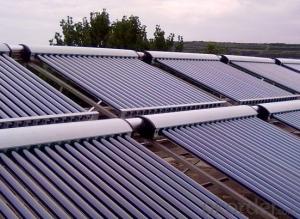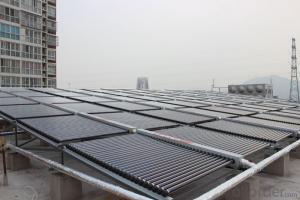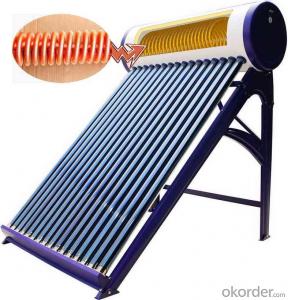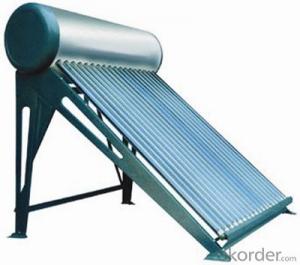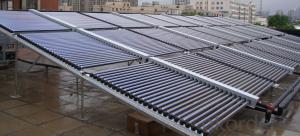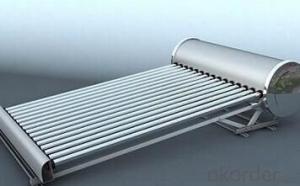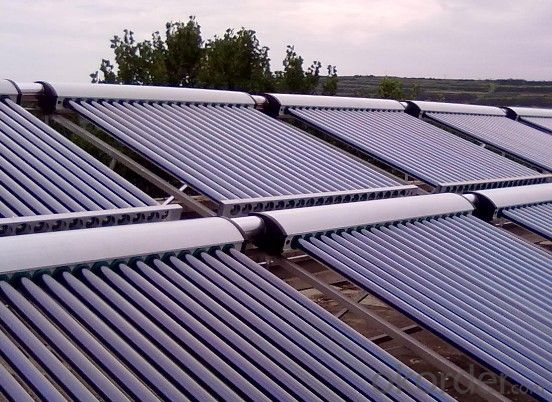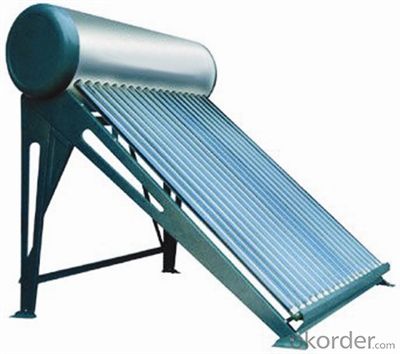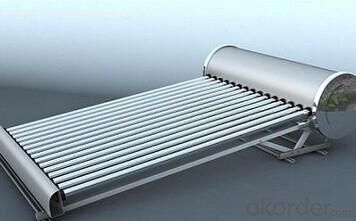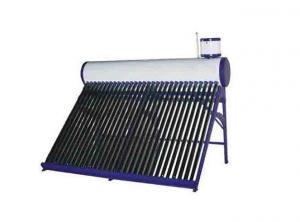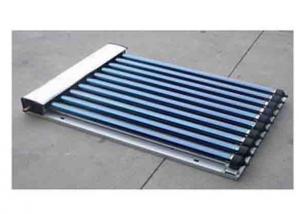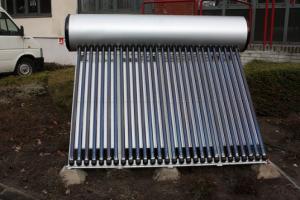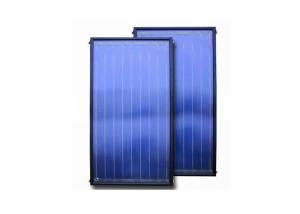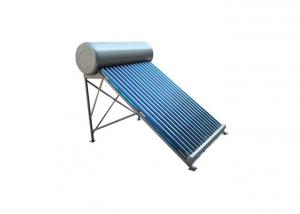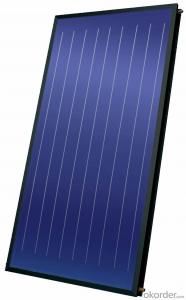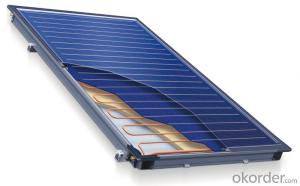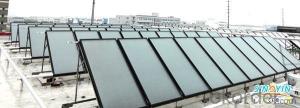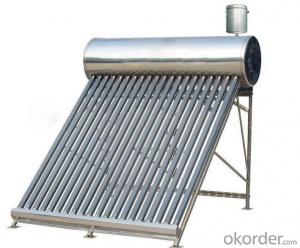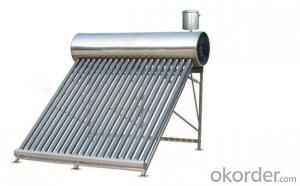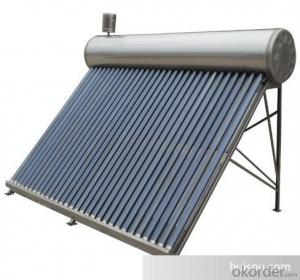Alpine TX Solar Collectors Copper Heat Pipe Solar Water Heater System
- Loading Port:
- China main port
- Payment Terms:
- TT OR LC
- Min Order Qty:
- 1 set
- Supply Capability:
- 6000 set/month
OKorder Service Pledge
OKorder Financial Service
You Might Also Like
Introduction of Non-Pressure Solar Water Heater:
Non-pressure Solar Heater is one of the most economical solar water heating device with pretty high efficiency at the same time. It consists of hot water storage tank, solar vacuum tubes with mouth plug in storage tank, and bracket supporting tank and tubes.When cold water in evacuated tubes is heated with solar irradiation, as the specific gravities of hot water and cold water are different, hotter water goes upward to storage tank and colder water goes downward to glass tubes. through this continuous circulation, the cold water in storage tank will be gradually heated till sunset.
Specialty:
1. High thermal performance and working temperature: the heat exchanging rate even in winter can up above 55%.
2. Heat collecting efficiency is at least 20% above common solar systems.
3. Work in all day and all season: no matter any corner of the world, this system can work well even -40℃ to avoid the tube freezing problem.
4. Reliability: No water following through the tube, so water scale can not generate and tube cracks could be avoided, the system still can keep working even with some damaged tubes.
5. It can connect with water tap and work automatically with pressure0.6Mpa, bring enjoyable washing experience.
6. Safety: P/T valve would release pressure and temperature to protect tank..
Technical Specification:
1. Outer tank material: SUS304 stainless steel or powder coated color steel
2. Inner tank material: 1.2mm thick SUS304 food grade stainless steel ( Optional material SUS316L)
3. Vacuum tube material: borosilicate glass 3.3; AL-SS-CU absorb coating, with copper heat pipe inside
4. Frame material: 1.2mm thickness stainless steel
5. Insulation material: 55mm thickness polyurethane
6. Suitable for mains pressure water(up to 8 bar/116psi)
7. Easy plug-in installation
8. Install the T/P valve on the pressurized tank
9. Seal material: Stabilized High Temperature Silicon
Outer tank material: SUS304 stainless steel or powder coated color steel
Inner tank material: 1.2mm thick SUS304 food grade stainless steel ( Optional material SUS316L)
Vacuum tube material: borosilicate glass 3.3; AL-SS-CU absorb coating, with copper heat pipe inside
Frame material: 1.2mm thickness stainless steel
Insulation material: 55mm thickness polyurethane
Suitable for mains pressure water(up to 8 bar/116psi)
Easy plug-in installation
Install the T/P valve on the pressurized tank
Seal material: Stabilized High Temperature Silicon
19. Vacuum Tube | 20. Size (mm) | 21. Φ47*1500 / Φ58*1800 / Φ70*2100 | |||||
22. Tube (pcs) | 23. 10 / 12 / 15 / 18 / 20 / 22 / 24 / 30 / 36 / 42 | ||||||
24. Material | 25. Borosilicate 3.3 glass, magnetron spluttering selective coating | ||||||
26. Coating | 27. Single-target AL-N/AL or Three-target AL/N-Cu-SS | ||||||
28. Water Tank | 29. Capacity | 30. 80L ~ 500L for hot water storage tank | |||||
31. Inner tank | 32. Food-grade stainless steel SUS304-2B / SUS316 | ||||||
33. Insulation | 34. High-density polyurethane foam with 70~80 hour heat preservation | ||||||
35. Tank shell | 36. Food-grade stainless steel SUS304-2B | ||||||
37. Bracket | 38. Shaped strong aluminum alloy structure adaptable for flat or slope roof | ||||||
39. Accessories | 40. Anti-aging silicon seals, Dustproof seals, Air-vent cap, Stainless screws | ||||||
41. Auxiliary Devices | 42. Assistant tank, Intelligent controller, Electrical heater, Magnesium anodes | ||||||
43. Tilt Angle | 44. 25 ~ 50° | ||||||
45. Water Output | 46. 45 - 95°C | ||||||
47. Hail Resistance | 48. Φ25mm diameter | ||||||
49. Model Number | 50. Solar Vacuum Tube | 51. Tank 52. Liter | 53. System 54. Liter | 55. Container Loading Qty /sets | |||
56. Size /mm | 57. Qty /pcs | 58. 20GP | 59. 40GP | 60. 40HQ | |||
61. VNS-58SA12-100 | 62. Φ58*1800 | 63. 12 | 64. 100 | 65. 132 | 66. 58 | 67. 119 | 68. 140 |
69. VNS-58SA15-130 | 70. 15 | 71. 130 | 72. 170 | 73. 54 | 74. 108 | 75. 131 | |
76. VNS-58SA18-150 | 77. 18 | 78. 150 | 79. 198 | 80. 43 | 81. 86 | 82. 105 | |
83. VNS-58SA20-170 | 84. 20 | 85. 170 | 86. 223 | 87. 40 | 88. 80 | 89. 97 | |
VNS-58SA24-200 | 24 | 200 | 263 | 35 | 70 | 85 | |
VNS-58SA30-250 | 30 | 250 | 329 | 28 | 56 | 68 | |
VNS-58SA36-300 | 36 | 300 | 395 | 23 | 47 | 57 | |
Product Show
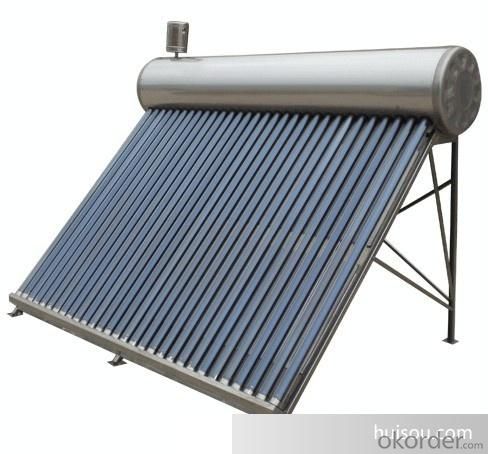
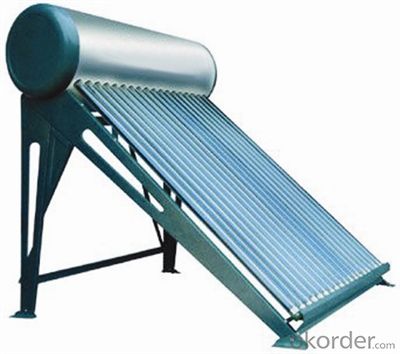
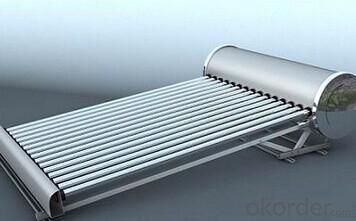
Our Services
1. OEM service
2. Warranty: 5 years
3. Considerable after sale service
Color steel Compact pressure Thermal solar heater
FAQ:
1. What’s the delivery time?
10 days after receiving deposit.
2. How long is the warranty?
5 years for whole system, 1 year for accessory
3. What’s your production capacity?
6000sets/month
4. What’s the MOQ?
1 set.
5. What’s your payment term?
Container: 30% T/T in advance for deposit, 70% T/T before shipment for fist order.
70% T/T after seeing copy of B/L from second order
Sample: 100% T/T in advance
Other choices: L/C at sight.
6. What certifications do you have?
CE, SOLAR KEYMARK, SRCC and etc.
- Q: Are there any disadvantages to using solar collectors?
- Yes, there are a few disadvantages to using solar collectors. Firstly, the initial cost of installing solar collectors can be quite high, making it less affordable for some individuals or businesses. Additionally, solar collectors require a significant amount of space for installation, which may limit their use in densely populated areas. Furthermore, solar collectors are dependent on sunlight, so their efficiency can be affected by variations in weather conditions or seasonal changes. Lastly, the manufacturing process of solar collectors can have environmental impacts, particularly if not properly recycled or disposed of at the end of their lifespan.
- Q: Can solar collectors be used for heating synagogues?
- Yes, solar collectors can be used for heating synagogues. Solar thermal systems can efficiently capture sunlight and convert it into heat energy, which can then be used for space heating in synagogues. This renewable energy source not only reduces carbon emissions but also provides a sustainable solution for heating the building.
- Q: What is the maintenance cost for solar collectors?
- The maintenance cost for solar collectors varies depending on various factors, such as the type of collector, its age, location, and environmental conditions. Generally, the maintenance cost includes routine inspections, cleaning, and occasional repairs or replacements of components. However, on average, the maintenance cost for solar collectors is relatively low compared to other energy systems, as they have few moving parts and require minimal upkeep.
- Q: Can solar collectors be used in cement factories?
- Yes, solar collectors can be used in cement factories. Solar thermal technology, such as solar collectors, can be utilized in cement manufacturing processes to provide heat for various purposes, such as preheating raw materials, drying fuels, or powering steam turbines. This can help reduce the reliance on fossil fuels, decrease carbon emissions, and make cement production more sustainable.
- Q: Can solar collectors be used for generating electricity during winter?
- Yes, solar collectors can be used for generating electricity during winter. While it is true that the amount of sunlight available during winter is generally lower than in other seasons, solar collectors can still generate electricity even in colder climates. Solar collectors work by converting sunlight into electricity using photovoltaic cells or solar thermal systems. Photovoltaic cells directly convert sunlight into electricity, while solar thermal systems use sunlight to heat a fluid, which then produces steam to generate electricity. During winter, solar collectors can still generate electricity because they rely on the presence of sunlight rather than heat. Even on cloudy or snowy days, there is still sunlight present, albeit in reduced quantities. Solar panels are designed to capture as much sunlight as possible, and advancements in technology have made them more efficient at converting sunlight into electricity, even in low-light conditions. Additionally, solar collectors can still be effective during winter as they do not rely solely on direct sunlight. They can also generate electricity from diffused sunlight, which is the light that passes through clouds or reflects off surfaces such as snow. While the overall electricity generation may be lower during winter compared to other seasons, solar collectors can still contribute to the energy needs of a household or a community. Moreover, some regions with colder climates have implemented policies or technologies to optimize solar collector performance during winter. For instance, solar collectors can be tilted at an angle to maximize the capture of sunlight. Snow can be cleared from the surface of the collectors to enhance their efficiency. Additionally, battery storage systems can be used to store excess electricity generated during sunny days for use during periods of low sunlight. In conclusion, solar collectors can be used for generating electricity during winter, although the amount of electricity produced may be lower compared to other seasons. However, advancements in technology and optimization strategies can help maximize solar collector performance even in cold and low-light conditions, making them a viable option for electricity generation throughout the year.
- Q: Can solar collectors be used for heating mining operations?
- Yes, solar collectors can be used for heating mining operations. Solar thermal systems can be designed and utilized to capture and convert solar energy into heat, which can be used for various applications including heating mining operations. This renewable energy source can reduce dependency on traditional fossil fuel-based heating systems, thereby promoting environmental sustainability and cost savings for mining operations.
- Q: How do solar collectors perform in polluted areas?
- Solar collectors can still perform well in polluted areas, although their efficiency may be slightly affected. The level of pollution can reduce the amount of sunlight reaching the collectors, leading to a decrease in their overall performance. However, regular cleaning and maintenance can help mitigate the impact of pollution and ensure optimal functioning of solar collectors in these areas.
- Q: How long does it take to install a solar collector?
- The time it takes to install a solar collector can vary depending on several factors, including the size and complexity of the system, the location of the installation, and the experience of the installer. Generally, a residential solar collector installation can take anywhere from a few days to a couple of weeks. However, larger commercial installations may take longer due to the increased complexity and scale. It is best to consult with a solar installer for a more accurate estimate based on your specific project.
- Q: Are solar collectors environmentally friendly?
- Yes, solar collectors are environmentally friendly as they harness the energy from the sun, a renewable source, to generate electricity or heat without emitting harmful greenhouse gases or pollutants. They help reduce dependence on fossil fuels and contribute to mitigating climate change.
- Q: Can solar collectors be used for heating driveways?
- Yes, solar collectors can be used for heating driveways. Solar collectors can absorb sunlight and convert it into heat energy, which can then be used to warm up driveways and prevent snow or ice from accumulating on the surface. This can be achieved through the use of radiant heating systems that circulate the heated fluid from the solar collectors beneath the driveway.
Send your message to us
Alpine TX Solar Collectors Copper Heat Pipe Solar Water Heater System
- Loading Port:
- China main port
- Payment Terms:
- TT OR LC
- Min Order Qty:
- 1 set
- Supply Capability:
- 6000 set/month
OKorder Service Pledge
OKorder Financial Service
Similar products
Hot products
Hot Searches
Related keywords
